Ten years ago, the first iPhone was released, which became the standard of the smartphone. But is the future so bright Apple, given the fact that the company itself has created competitors for itself?
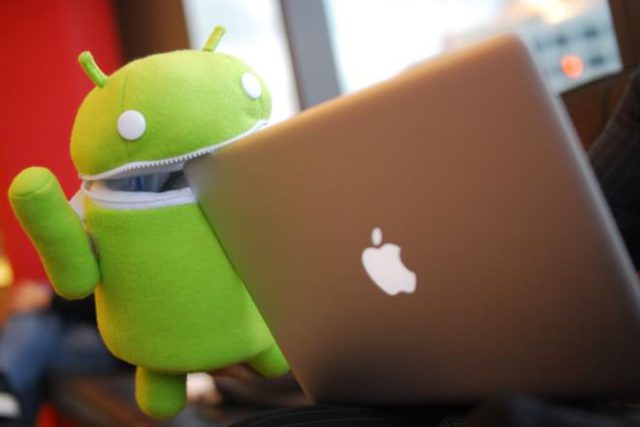
Round dates are a great occasion to reflect on the past and imagine how past events might be reflected in the future. For some, the next anniversary becomes a time of confirmation of existing opinions, for others it is an opportunity to realize and accept the lessons of the past and move on.
More recently, analysts and wholesalers from the mobile electronics industry returned from CES from Las Vegas with a host of gadgets and mobile devices pending in the near future. Not all of these devices will pass the project stage or enter the main markets, but the exhibition itself is a good indicator of what awaits us in terms of technology. Since 1992, the exhibition has been suspiciously avoided by the company Apple. Not that no one noticed this 'bishop', the absence of such a player is more than noticeable.
For at least 15 years since the breakthrough iPod was announced in 2001, every analyst walked into a huge and well-air-conditioned Las Vegas convention center and realized that regardless of the products presented at the show, within a few months the company from Cupertino will release something that can radically shift the vector of discussion when it comes to reviews and impact on the mobile electronics industry.
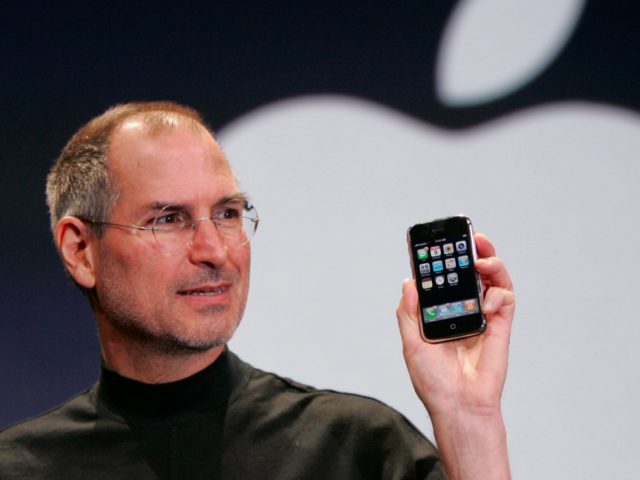
A similar large-scale shift happened a little more than ten years ago, it was the announcement of the first iPhone. The device was not the first smartphone. BlackBerry and Windows CE were a dozen years ahead of it, and Palm has successfully 'put' its personal digital assistants into smartphones. However, none of the listed players could boast of the same combination of functional features and significant features as iPhone, albeit in that early and most primitive iteration of the June 2007 sample. After the release of this device Apple, and did what actually determined the current state of the platforms for smartphones: introduced its own catalog of applications and tools for software developers for iPhone, and also ensured the independence of the device from PC sync to download music and other media files, which has staked out iPhone a pioneering role in the 'post-PC' era. This freedom has transformed and elevated the smartphone.
The success iPhone was partly due to the well-established logistics and production infrastructure, which made possible large volumes of direct orders and resale. To this end, CEO Apple Steve Jobs in January 2007 appointed a former employee IBM, 'veteran' Apple, who had worked for the company for 10 years at that time. Tim Cook, an expert in the management and implementation of global logistics.
The rest is already known to everyone, this story is the most prominent example of success in the chronicle of the development of the technology industry. But iPhone not only turned Apple into an industry giant. In the process, he created other big players as well. He became something of a super catalyst. The supply chain infrastructure Kuku needed to produce iPhone (and later iPad) required the resources of many Asian companies to be leveraged. This list includes, among others, Samsung with its microprocessors, displays, batteries and DRAM, Sharp and its displays, and Hon Hai Precision Industry, known as Foxconn, and its integrated manufacturing.
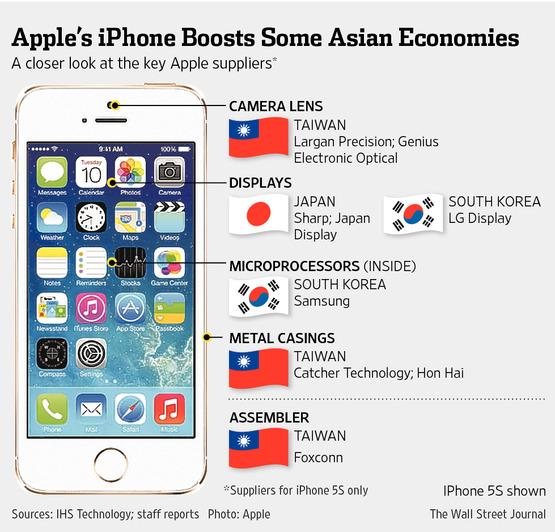
WSJ
The experience gained by these companies in the process of fulfilling orders Apple gave them the knowledge necessary to directly fight the American company. Samsung has benefited most from this and has become an independent player in the smartphone and tablet market, in addition to building its own highly profitable contract manufacturing business. Then Android, an easily accessible and growing open source mobile operating system, appeared on the market, which only accelerated the formation of such companies as independent players.
Samsung has dominated the Android smartphone market for many years. Given China's manufacturing resources, the size of the country's labor force, and the size of the smartphone home market, it is clear that China's expertise in smartphone manufacturing will sooner or later expand outside the country. For Samsung, the situation was exacerbated by the 2011 Tohoku earthquake in Japan, which wiped out the Japanese mobile electronics industry and accelerated the country's economic slowdown and lost competitiveness in consumer electronics. This led to the purchase by Foxconn of the technology leader OLED and IGZO displays from Sharp in August 2016. And now the Taiwanese company Foxconn, with significant manufacturing capabilities and a presence in the mainland of China, has the key Japanese technology used in iPhone. The industrial capacity of Guangdong and Sichuayan could be built on iPhone and iPad, but their future was destined to be formed at the expense of Android.
The think tank of the Asian smartphone market has spread across the five largest Chinese companies – Huawei, ZTE, Lenovo, Xiaomi and Oppo, which has contributed to the development of manufacturing capabilities similar to those which were actually abandoned in Apple. As these 'horsemen of the apocalypse' battled for global market share by gradually reducing the cost of premium products, users began to benefit. We no longer have to choose between two premium flagships from two manufacturers.
The movement was led by the company Huawei, which became the contractor for the release of the Google Nexus 6P smartphone. After the first wave of success in North America, Huawei launched its branded smartphones in many international markets, first with Qualcomm processors and then with ARM's own multi-core chips called HiSilicon Kirin 9xx. The company demonstrated its ability to play on equal terms with Samsung and Apple in terms of build quality and last summer released a much cheaper but nonetheless premium dual camera smartphone P9, which overtook iPhone 7 Plus. This was quickly followed by a more value-for-money solution – Honor 8, which received positive reviews from many in the specialist publications for its design and excellent performance.
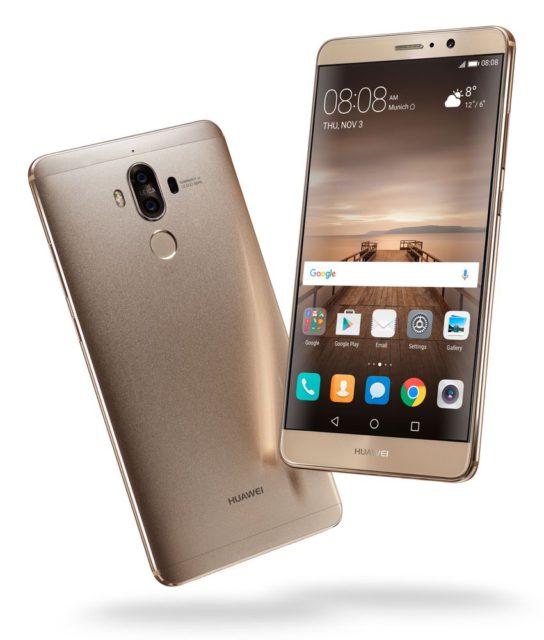
This year at CES, right after the Samsung Galaxy Note 7 fiasco, Huawei unveiled its flagship Mate 9 phablet. Early reviews were overwhelmingly positive. I have been using the device for several weeks and it can easily compete with the Galaxy Note 7 and iPhone 7 Plus, while its cost is lower and it does not have the explosive nature of the infamous Samsung device. And if you are worried that you are not spending enough money on a Chinese smartphone in order to impress your friends, then you always have the opportunity to buy Huawei Mate 9 – Porsche Design – a version of the device with 6 GB of RAM , 256 GB of disk space and a display with a resolution of 2K, made using technology AMOLED.
Nobody knows the cost of this device yet. I had the experience of communicating with him, this is the most beautiful of all released Android – smartphones. It can be easily noted that the Chinese 'Android – monster' represented by Huawei and other companies is the work of hands Apple and the main reason for the slowdown in the company's growth and the loss of dominance in market. But this is not the only reason. Apple is a victim of your own success. She made so much money from iPhone that she chose to relax and product announcements became completely streamlined and cyclical, became clumsy and after Jobs's death and Cook's transition to CEO ceased to respond to consumer needs.
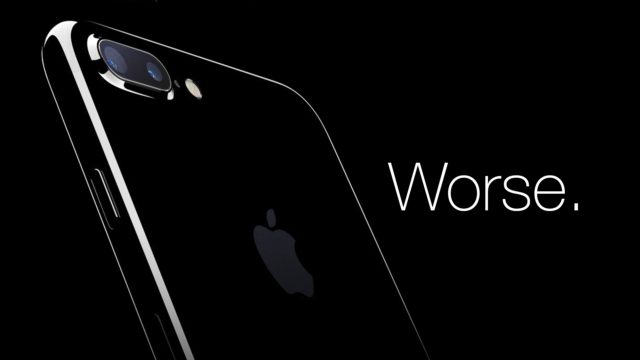
Well, in fact, what can you expect from a brilliant specialist in logistics and production optimization who has become the head of the company, who boldly abandons the fundamental components of devices / ecosystems every five to ten years? How else can you explain the completely iterative iPhone 7 with a 3.5mm 'portectomy' and the new MacBook Pro with an outdated Star Trek: The Next Generation LED panel with questionable functionality, incomplete touchscreen implementation , a nightmare in the form of a chain of adapters, from which even fans Apple started scratching their heads?
Of course, ditch key functionality instead of a complete redesign. This is the recipe for success. I know of another huge technology company from the West Coast who can share their experience by example. They eventually hired a new CEO. Everything is just 'super' with him.
Former employee Apple and Silicon Valley researcher Chuk Won Rospah captured this point especially well in a blog post:
Apple has always been an information-driven company, but I find that they have become too much of that information in their business decisions. Plates can show the tidbits of the market and how to 'eat them off', but they are unlikely to be able to find and highlight strategic areas that were not previously covered. And that is where Steve succeeded, by the way. This means that the company must be led by people who understand their users and know which aspects are strategically important and require additional coverage.
The opinion Apple of its users is not true, I believe that the company has lost the vision of its user base. They have a general idea of it, but over the past 18 months, it has often happened that the reaction of the public was different from what the company would like to receive.
Unlike Cook, Jobs was a Silicon Valley god who sacrificed everything for the product line. I was not completely sure of him during his lifetime, but looking back, even with all my doubts about his manner of communicating with partners and developers and killing customers, I understand that he had an incredible ability to force the company to take revolutionary steps. Apple now there are many people capable of another revolution in the market. The problem is that these are not the people who manage the company's revenues. Instead, they work on various R&D and lines of competence that are not the most profitable part of the company. The culture Apple has ceased to come from the company itself so much that any person from such structures who daring and nursing the potential a breakthrough idea for their side enrichment project will literally be shot on the spot.
Apple has created a 'Chinese monster', the company needs to change the direction of movement and make another revolution, otherwise all conversations around mobile electronics in the future will be conducted in Mandarin Chinese.
Original material by Jason Perlow
The tread of Chinese smartphones around the world cannot be stopped, the markets are flooded with a variety of models from both small and impressive companies. Of course, this trend could not pass by Apple, which, according to the author, indirectly brewed this mess. In my opinion, the popularity of devices with an 'apple' is not so easy to overcome, but in the absence of significant innovations, interest will fall, which, according to analysts, is happening with iPhone 7/7 Plus. Users think differently and still willingly buy new items, albeit not in such volumes. But the 'Chinese monster' can no longer be stopped, and a disappointing picture for the current market leaders is emerging, which will force them to either put up with the state of affairs and the loss of market share, or push them to take decisive action and bold innovations.
The potential of the aforementioned Chinese manufacturers cannot be underestimated, the companies have serious means and capabilities, they are ready to fight for the markets of the world. Tactics are mostly based on copying and applying other people's developments in their devices, but in war all means are good. Well, it's worth giving it credit, the Chinese devices turn out to be very worthy, if you understand all the insanity of variations, you can find pleasant offers. And no matter who is at the helm of this revolution, the rest of the market will have a very difficult time. Maybe for the better?
